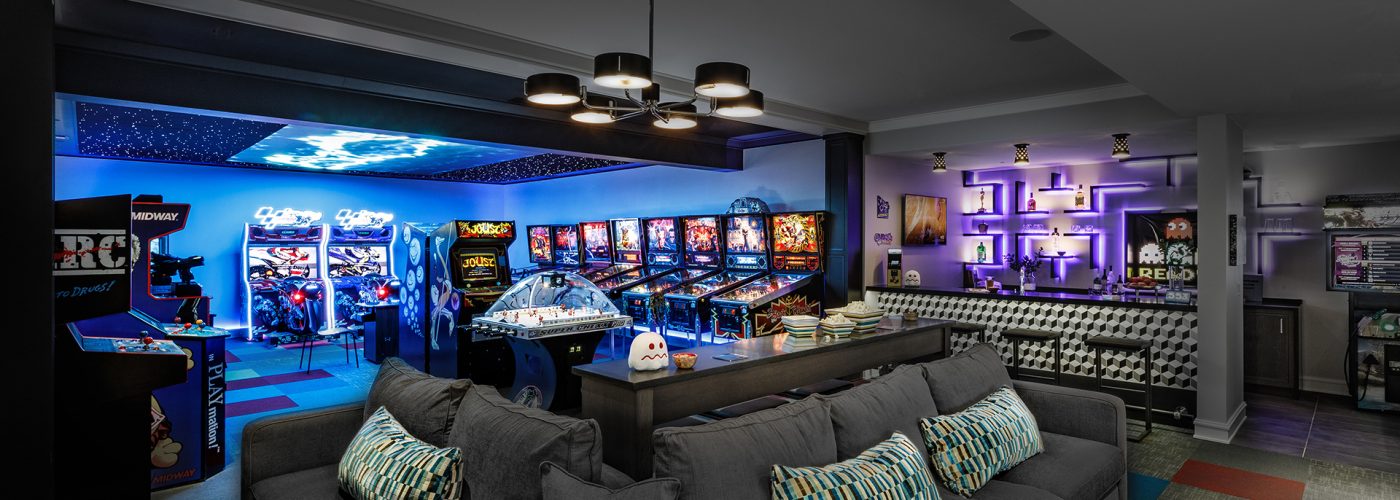The gaming landscape is no longer confined to living rooms and basements; it’s breaking boundaries and shaping our world in far-reaching, fascinating ways. For example, gaming lounges, designed as social havens for gaming enthusiasts, are making waves in the leisure industry.
These dynamic spaces offer not just games but an environment that thrives on interaction, competition, and immersive experiences. So, let’s navigate this exciting terrain together. We’ll explore the unique design elements that bring these spaces to life and look at their transformative impact on our social and gaming spheres. Keep reading to learn all about the interesting interaction between gaming and interior design.
Background of Gaming Lounges
Gaming lounges, which can trace their origins back to the traditional arcades of the 70s and 80s, have undergone a dramatic transformation over the years. Once the homes to pixelated classics and pinball machines, they have evolved into modern social hubs dedicated to video gaming. This shift was motivated by the increasing complexity and interactivity of games, necessitating a more immersive environment for players. Gaming lounges today offer a platform for eSports and social gaming, attracting a diverse range of gamers with their communal atmosphere and advanced technology.
The rise of digital casino gaming has also contributed to the trend. For example, the Dr. Toonz slot game available on PokerStars Casino demonstrates the appeal of modern gaming lounges. This space-themed title features a variety of colorful extra-terrestrial characters created by a UFO-riding scientist. With its dynamic features, such as the cascading and Quantumeter features, Dr. Toonz exemplifies the immersive, interactive gaming experience that gaming lounges increasingly offer. The trend towards these sophisticated developments points towards a bright future for gaming lounges.

Design in gaming lounges isn’t just about curating a visually appealing space. It’s about crafting an environment that amplifies the gaming experience. Every element, from the mood-setting lighting and soundproofing to the arrangement of seats and gaming equipment, is meticulously planned. The goal? To create a space where gamers can truly immerse themselves in their digital adventures while ensuring comfort for extended play sessions.
Essential Features of Gaming Lounge Design
Designing a gaming lounge is akin to assembling a puzzle, with each piece equally crucial. Naturally, state-of-the-art gaming equipment sits at the core. But a host of other elements come into play. Comfortable seating arrangements ensure gamers can enjoy longer sessions without discomfort, while the lighting is tweaked to create an engaging atmosphere without straining the eyes. Soundproofing enhances the immersive experience of the game’s sounds without causing noise disruptions.
Advancements in technology also leave their mark on gaming lounge design. Uninterrupted, high-speed internet access is vital for smooth online gameplay, while virtual reality (VR) spaces and large screens cater to the evolving tastes of the gaming community.
Gaming Lounge Designs Around the World
Across the globe, numerous gaming lounges have successfully crafted spaces that resonate with gamers and spectators alike. Take Tokyo’s Esports SQUARE, renowned for its plush seating, top-notch gaming gear, and large screens that let spectators partake in the thrill of the game. Melbourne’s Fortress Esports lounge is another stellar example, boasting dedicated gaming zones, observer seating, and a bouquet of tech-forward features.
Impact of Gaming Lounges on the Hospitality Industry
The rise of gaming lounges is shaking up the leisure and hospitality industry. Traditional venues, including hotels and restaurants, are increasingly weaving gaming lounges into the fabric of their buildings, aiming to attract tech-savvy audiences. This blend of gaming and hospitality not only diversifies their clientele but also infuses a unique flavor into their services.
Future Trends in Gaming Lounge Design
As the gaming community’s needs and preferences evolve, so will the landscape of gaming lounges. Looking ahead, we might see more VR and augmented reality spaces, integrated eSports facilities for hosting professional gaming events, and highly personalized gaming environments. The guiding principle remains the same: crafting immersive, comfortable, and technologically advanced spaces that meet the needs of modern gamers. As gaming continues its meteoric rise in popularity, gaming lounges will undoubtedly be at the forefront, shaping the future of the leisure and hospitality industry.





